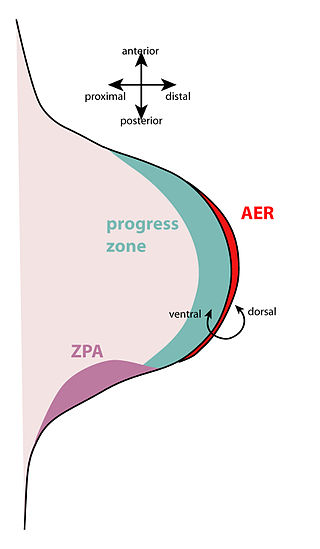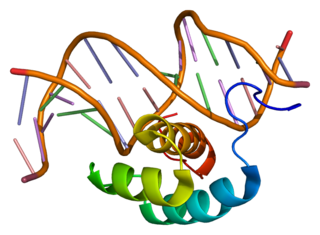Related Research Articles

A homeobox is a DNA sequence, around 180 base pairs long, that regulates large-scale anatomical features in the early stages of embryonic development. Mutations in a homeobox may change large-scale anatomical features of the full-grown organism.
The ParaHox gene cluster is an array of homeobox genes from the Gsx, Xlox (Pdx) and Cdx gene families.
Hox genes, a subset of homeobox genes, are a group of related genes that specify regions of the body plan of an embryo along the head-tail axis of animals. Hox proteins encode and specify the characteristics of 'position', ensuring that the correct structures form in the correct places of the body. For example, Hox genes in insects specify which appendages form on a segment, and Hox genes in vertebrates specify the types and shape of vertebrae that will form. In segmented animals, Hox proteins thus confer segmental or positional identity, but do not form the actual segments themselves.

The apical ectodermal ridge (AER) is a structure that forms from the ectodermal cells at the distal end of each limb bud and acts as a major signaling center to ensure proper development of a limb. After the limb bud induces AER formation, the AER and limb mesenchyme—including the zone of polarizing activity (ZPA)—continue to communicate with each other to direct further limb development.
The limb bud is a structure formed early in vertebrate limb development. As a result of interactions between the ectoderm and underlying mesoderm, formation occurs roughly around the fourth week of development. In the development of the human embryo the upper limb bud appears in the third week and the lower limb bud appears four days later.
In the field of developmental biology, regional differentiation is the process by which different areas are identified in the development of the early embryo. The process by which the cells become specified differs between organisms.

Homeobox protein CDX-2 is a protein that in humans is encoded by the CDX2 gene. The CDX2 protein is a homeobox transcription factor expressed in the nuclei of intestinal epithelial cells, playing an essential role in the development and function of the digestive system. CDX2 is part of the ParaHox gene cluster, a group of three highly conserved developmental genes present in most vertebrate species. Together with CDX1 and CDX4, CDX2 is one of three caudal-related genes in the human genome.

Homeobox protein Hox-B7 is a protein that in humans is encoded by the HOXB7 gene.

Paired-like homeodomain transcription factor 2 also known as pituitary homeobox 2 is a protein that in humans is encoded by the PITX2 gene.

Homeobox protein Hox-B6 is a protein that in humans is encoded by the HOXB6 gene.

Homeobox protein Hox-A1 is a protein that in humans is encoded by the HOXA1 gene.

Homeobox protein Hox-A3 is a protein that in humans is encoded by the HOXA3 gene.

Homeobox protein CDX-1 is a protein in humans that is encoded by the CDX1 gene. CDX1 is expressed in the developing endoderm and its expression persists in the intestine throughout adulthood. CDX1 protein expression varies along the intestine, with high expression in intestinal crypts and diminishing expression along intestinal villi.

Homeobox protein GBX-2 is a protein that in humans is encoded by the GBX2 gene.

The zone of polarizing activity (ZPA) is an area of mesenchyme that contains signals which instruct the developing limb bud to form along the anterior/posterior axis. Limb bud is undifferentiated mesenchyme enclosed by an ectoderm covering. Eventually, the limb bud develops into bones, tendons, muscles and joints. Limb bud development relies not only on the ZPA, but also many different genes, signals, and a unique region of ectoderm called the apical ectodermal ridge (AER). Research by Saunders and Gasseling in 1948 identified the AER and its subsequent involvement in proximal distal outgrowth. Twenty years later, the same group did transplantation studies in chick limb bud and identified the ZPA. It wasn't until 1993 that Todt and Fallon showed that the AER and ZPA are dependent on each other.
Homeotic genes are genes which regulate the development of anatomical structures in various organisms such as echinoderms, insects, mammals, and plants. Homeotic genes often encode transcription factor proteins, and these proteins affect development by regulating downstream gene networks involved in body patterning.
The Cdx protein family is a group of the transcription factor proteins which bind to DNA to regulate the expression of genes. In particular this family of proteins can regulate the Hox genes. They are regulators of embryonic development and hematopoiesis in vertebrates, and are also involved in the development of some types of gastrointestinal cancers and leukemias.
tinman, or tin is an Nk2-homeobox containing transcription factor first isolated in Drosophila flies. The human homolog is the Nkx2-5 gene. tinman is expressed in the precardiac mesoderm and is responsible for the differentiation, proliferation, and specification of cardiac progenitor cells. This gene is named after the character Tin Woodman who lacks a heart, as flies with nonfunctional tinman genes have cardiac deformities.

Hox genes play a massive role in some amphibians and reptiles in their ability to regenerate lost limbs, especially HoxA and HoxD genes.

Homeobox protein CDX-4 is a protein that in humans is encoded by the CDX4 gene. This gene is a member of the caudal-related homeobox transcription factor family that also includes CDX1 and CDX2.
References
- ↑ Mlodzik, Marek; Fjose, Anders; Gehring, Walter J. (1985). "Isolation of caudal, a Drosophila homeo box-containing gene with maternal expression, whose transcripts form a concentration gradient at the pre-blastoderm stage". The EMBO Journal. 4 (11): 2961–9. doi:10.1002/j.1460-2075.1985.tb04030.x. PMC 554605 . PMID 16453641.
- ↑ "FlyBase cad gene" . Retrieved 7 December 2012.
- ↑ Mulley, John F.; Chiu, Chi-hua; Holland, Peter W. H. (2006). "Breakup of a homeobox cluster after genome duplication in teleosts". Proceedings of the National Academy of Sciences. 103 (27): 10369–72. Bibcode:2006PNAS..10310369M. doi: 10.1073/pnas.0600341103 . JSTOR 30049630. PMC 1502464 . PMID 16801555.
- ↑ Holland, Peter W. H.; Brooke, Nina M.; Garcia-Fernàndez, Jordi (1998). "The Para Hox gene cluster is an evolutionary sister of the Hox gene cluster". Nature. 392 (6679): 920–2. Bibcode:1998Natur.392..920B. doi:10.1038/31933. PMID 9582071. S2CID 4398740.
- ↑ Foley, TE; Hess, B; Savory, JGA; Ringuette, R; Lohnes, D (1 April 2019). "Role of Cdx factors in early mesodermal fate decisions". Development. 146 (7): dev170498. doi: 10.1242/dev.170498 . PMID 30936115.
- ↑ Neijts, Roel; Amin, Shilu; Van Rooijen, Carina; Deschamps, Jacqueline (2017). "Cdx is crucial for the timing mechanism driving colinear Hox activation and defines a trunk segment in the Hox cluster topology". Developmental Biology. 422 (2): 146–154. doi: 10.1016/j.ydbio.2016.12.024 . PMID 28041967.
- ↑ Charité, Jeroen; de Graaff, Wim; Consten, Dimitri; Reijnen, Mark J.; Korving, Jeroen; Deschamps, J (1998). "Transducing positional information to the Hox genes: Critical interaction of cdx gene products with position-sensitive regulatory elements". Development. 125 (22): 4349–58. doi:10.1242/dev.125.22.4349. PMID 9778495. S2CID 44221462.
- ↑ Van De Ven, Cesca; Bialecka, Monika; Neijts, Roel; Young, Teddy; Rowland, Jennifer E.; Stringer, Emma J.; Van Rooijen, Carina; Meijlink, Frits; Nóvoa, Ana; Freund, Jean-Noel; Mallo, Moises; Beck, Felix; Deschamps, Jacqueline (2011). "Concerted involvement of Cdx/Hox genes and Wnt signaling in morphogenesis of the caudal neural tube and cloacal derivatives from the posterior growth zone". Development. 138 (16): 3451–62. doi: 10.1242/dev.066118 . hdl: 10400.7/644 . PMID 21752936.
- ↑ Beck, F (October 2004). "The role of Cdx genes in the mammalian gut". Gut. 53 (10): 1394–1396. doi: 10.1136/gut.2003.038240 . PMC 1774238 . PMID 15361482.